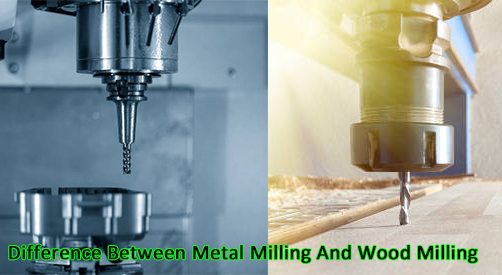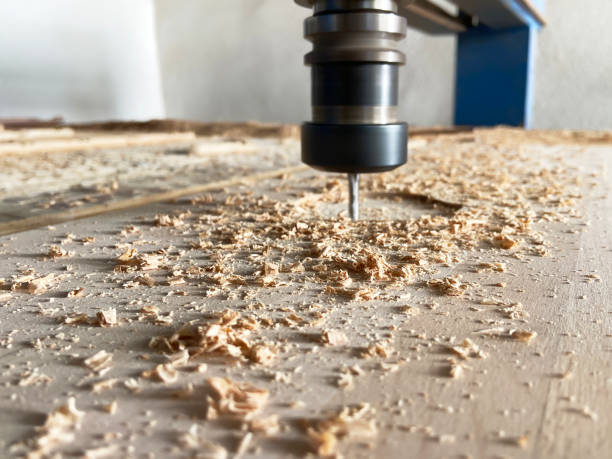การกัดเป็นกระบวนการกลึงที่นิยมใช้ในการขึ้นรูปวัสดุแข็งโดยการกำจัดชิ้นส่วนที่ไม่ต้องการโดยใช้เครื่องมือตัดแบบหมุน เป็นเทคนิคที่ใช้กันอย่างแพร่หลายในอุตสาหกรรมต่างๆ เพื่อผลิตชิ้นส่วนที่แม่นยำและซับซ้อน ด้วยความช่วยเหลือของเครื่องจักร CNC (การควบคุมเชิงตัวเลขด้วยคอมพิวเตอร์) การกัดจึงมีประสิทธิภาพ แม่นยำ และสม่ำเสมอมากขึ้น
แม้ว่ากระบวนการกัดอาจดูคล้ายกันในแต่ละวัสดุ แต่มีความแตกต่างอย่างมากระหว่างการกัดโลหะกับการกัดไม้ วัสดุแต่ละชนิดมีพฤติกรรมที่แตกต่างกันในระหว่างการกลึง โดยต้องใช้เครื่องมือ เทคนิค และการตั้งค่าเครื่องจักรที่เฉพาะเจาะจง ตัวอย่างเช่น โลหะโดยทั่วไปจะแข็งกว่าและมีความหนาแน่นมากกว่า ในขณะที่ไม้จะอ่อนกว่าและมีแนวโน้มที่จะแตกเป็นเสี่ยงหรือไหม้ได้ง่ายกว่า
การทำความเข้าใจความแตกต่างเหล่านี้ถือเป็นสิ่งสำคัญเมื่อเลือกเครื่องจักรและเครื่องมือ CNC เครื่องจักรที่ออกแบบมาเพื่อตัดไม้อาจไม่ทรงพลังเพียงพอสำหรับตัดโลหะ และเครื่องมือที่ออกแบบมาเพื่อตัดโลหะอาจทำให้พื้นผิวไม้เนื้ออ่อนเสียหายได้ ไม่ว่าคุณจะอยู่ในอุตสาหกรรมการผลิต งานไม้ หรือการสร้างต้นแบบ การรู้ว่าเครื่องมือและเครื่องจักรใดเหมาะกับวัสดุของคุณจะช่วยให้ได้ผลลัพธ์ที่ดีกว่า อายุการใช้งานเครื่องมือที่ยาวนานขึ้น และการทำงานที่ปลอดภัยยิ่งขึ้น
ในบทความนี้ เราจะสำรวจว่าการกัดโลหะและการกัดไม้แตกต่างกันอย่างไรในแง่ของพฤติกรรมของวัสดุ เครื่องมือ เครื่องจักร และการใช้งานในโลกแห่งความเป็นจริง
การกัดเป็นกระบวนการตัด ขึ้นรูป และขจัดวัสดุออกจากชิ้นงานแข็ง ซึ่งทำได้โดยใช้เครื่องมือตัดแบบหมุนที่เคลื่อนที่ไปตามแกนต่างๆ เพื่อสร้างรูปร่างและพื้นผิวที่แม่นยำ การกัดสามารถใช้สร้างพื้นผิวเรียบ ช่อง รู และชิ้นส่วน 3 มิติที่ซับซ้อนได้
ปัจจุบันงานกัดส่วนใหญ่ทำโดยใช้เครื่อง CNC ซึ่งเป็นคำย่อของ Computer Numerical Control เครื่องจักรเหล่านี้ควบคุมด้วยซอฟต์แวร์ที่ตั้งโปรแกรมไว้ล่วงหน้าซึ่งทำหน้าที่ตัดแบบอัตโนมัติ ด้วยระบบกัด CNC งานที่เคยใช้เวลาหลายชั่วโมงก็สามารถทำได้เร็วขึ้น มีความแม่นยำและสม่ำเสมอมากขึ้น
การกัดมีหลายประเภทขึ้นอยู่กับเป้าหมาย การกัดหน้าจะสร้างพื้นผิวเรียบโดยใช้หน้าของเครื่องมือ การกัดปลายใช้ปลายและด้านข้างของเครื่องมือในการตัดร่อง ช่องว่าง และรูปร่างที่มีรายละเอียดมากขึ้น เทคนิคทั่วไปอื่นๆ ได้แก่ การกัดร่อง การกัดตามรูปร่าง และการเจาะ
การกัดสามารถใช้ได้กับวัสดุต่าง ๆ แต่โลหะและไม้เป็นวัสดุที่นิยมใช้กันมากที่สุด วัสดุเหล่านี้ต้องการเครื่องมือ ความเร็ว และวิธีการที่แตกต่างกันเนื่องจากมีคุณสมบัติเฉพาะตัว การกัดโลหะต้องใช้ความพยายามมากกว่าเนื่องจากโลหะมีความแข็งและเหนียว ในขณะที่การกัดไม้จะเน้นที่การรักษาพื้นผิวให้เรียบเนียนและป้องกันเสี้ยนหรือรอยไหม้
การทำความเข้าใจคุณสมบัติของวัสดุที่จะทำการกัดถือเป็นสิ่งสำคัญในการเลือกเครื่องมือและการตั้งค่าเครื่องจักรที่เหมาะสม โลหะและไม้มีพฤติกรรมที่แตกต่างกันมากในระหว่างกระบวนการกัด และแต่ละอย่างก็มีความท้าทายที่แตกต่างกัน

โลหะเป็นที่รู้จักกันดีในเรื่องความแข็ง ความแข็งแกร่ง และความทนทาน คุณสมบัติเหล่านี้ทำให้โลหะเหมาะอย่างยิ่งสำหรับการสร้างชิ้นส่วนที่แข็งแกร่งและใช้งานได้ยาวนาน อย่างไรก็ตาม คุณสมบัติเดียวกันนี้ยังทำให้โลหะกลึงได้ยากขึ้นอีกด้วย การตัดผ่านวัสดุที่แข็ง เช่น เหล็ก อลูมิเนียม หรือไททาเนียม ต้องใช้เครื่องจักรที่มีกำลังสูง เครื่องมือตัดที่แข็งแกร่ง และการควบคุมที่แม่นยำ
เนื่องจากโลหะมีความแข็งและหนาแน่น จึงทำให้เกิดความร้อนและแรงเสียดทานสูงในระหว่างการกัด ซึ่งหมายความว่าผู้ปฏิบัติงานมักจะต้องใช้สารหล่อเย็นหรือน้ำมันหล่อลื่นเพื่อป้องกันไม่ให้เครื่องมือร้อนเกินไป นอกจากนี้ กระบวนการกัดโลหะยังมีแนวโน้มที่จะช้ากว่าปกติ เนื่องจากการเร่งรีบอาจทำให้เครื่องมือหรือวัสดุเสียหายได้
● อลูมิเนียม – น้ำหนักเบา ง่ายต่อการบด เหมาะสำหรับต้นแบบและชิ้นส่วนยานยนต์
● เหล็ก (อ่อน, สแตนเลส) – แข็งแรงทนทาน ใช้ในส่วนประกอบอุตสาหกรรมและโครงสร้าง
● ทองเหลือง – มีความยืดหยุ่นและทนต่อการกัดกร่อน เหมาะสำหรับอุปกรณ์และของตกแต่ง
● ไทเทเนียม – แข็งแรงมากและทนความร้อนได้ดี ใช้ในส่วนประกอบของอุตสาหกรรมการบินและอวกาศและการแพทย์
● ทองแดง – เป็นสื่อไฟฟ้าและอ่อนนุ่ม มักใช้ในส่วนประกอบไฟฟ้า
ไม้มีความอ่อนกว่า เบากว่า และยืดหยุ่นกว่า ทำให้ตัดได้ง่ายกว่าแต่ก็มีความละเอียดอ่อนในการใช้งานด้วย หนึ่งในความท้าทายที่ใหญ่ที่สุดเกี่ยวกับไม้คือความแปรปรวนตามธรรมชาติ ไม้แต่ละประเภทมีพฤติกรรมที่แตกต่างกันในระหว่างการแปรรูป ตัวอย่างเช่น ไม้เนื้อแข็ง เช่น ไม้โอ๊คหรือเมเปิ้ลมีความหนาแน่นและเหนียวกว่าไม้เนื้ออ่อน เช่น ไม้สนหรือซีดาร์
ไม้ไม่ไวต่อความร้อนและแรงเสียดทาน ต่างจากโลหะ หากตัดด้วยความเร็วมากเกินไป ไม้ก็อาจไหม้หรือแตกเป็นเสี่ยงได้ นอกจากนี้ ทิศทางของลายไม้ยังส่งผลต่อคุณภาพของการตัดได้ จึงต้องใช้ความเอาใจใส่เป็นพิเศษระหว่างการตัด
● ต้นสน – ไม้เนื้ออ่อน ใช้งานง่าย เหมาะสำหรับทำเฟอร์นิเจอร์และกรอบรูป
● ต้นโอ๊ค – ไม้เนื้อแข็งเนื้อแน่น แข็งแรงทนทาน นิยมใช้ทำตู้และปูพื้น
● เมเปิ้ล – ไม้เนื้อแข็งเนื้อเรียบมีลายไม้ละเอียด เหมาะสำหรับใช้ตัดเขียงและเฟอร์นิเจอร์ระดับไฮเอนด์
● ไม้เรียว – ไม้เนื้อแข็งความหนาแน่นปานกลาง ใช้ในไม้อัดและองค์ประกอบตกแต่ง
● วอลนัท – ไม้เนื้อแข็งสีเข้มและหรูหรา นิยมนำมาทำเฟอร์นิเจอร์หรูหราและตกแต่งภายใน
โดยสรุป การกัดโลหะต้องใช้พลังงานมากกว่า เครื่องมือที่แข็งแกร่งกว่า และการควบคุมความร้อนที่ดีกว่า ในขณะที่การกัดไม้ต้องใช้การตัดที่ราบรื่นกว่า การควบคุมความเร็วอย่างระมัดระวัง และการรับรู้ลายไม้ การเลือกวิธีการที่เหมาะสมตามวัสดุจะช่วยป้องกันความเสียหาย เพิ่มประสิทธิภาพ และรับประกันผลลัพธ์ที่มีคุณภาพสูง
คุณสมบัติ | งานกัดโลหะ | การแปรรูปไม้ |
ความแข็งของวัสดุ | แข็งและหนาแน่น | ความแข็งระดับอ่อนถึงปานกลาง |
ข้อกำหนดของเครื่องมือ | เครื่องมืองานหนัก (คาร์ไบด์, HSS) | เครื่องมือที่มีน้ำหนักเบา (ดอกกัด, HSS) |
การเกิดความร้อน | สูง – ต้องใช้สารหล่อเย็น/น้ำมันหล่อลื่น | ปานกลาง – เสี่ยงต่อการไหม้เมื่อขับด้วยความเร็วสูง |
ความไวต่อพื้นผิว | พื้นผิวมีความทนทานต่ำ | สูง – มีแนวโน้มที่จะแตกและฉีกขาด |
ผลกระทบต่อทิศทางของเมล็ดพืช | No | เกรนแบบใช่ส่งผลต่อคุณภาพการตัด |
วัสดุทั่วไป | เหล็ก, อลูมิเนียม, ไททาเนียม | ไม้โอ๊ค, เมเปิ้ล (ไม้เนื้อแข็ง); ไม้สน, ซีดาร์ (ไม้เนื้ออ่อน) |
ความเร็วในการกลึง | ช้าลงเพื่อความแม่นยำและอายุการใช้งานของเครื่องมือ | เร็วกว่าแต่ต้องควบคุมความเร็วเพื่อคุณภาพ |
ประเภทของวัสดุที่จะทำการกัด ไม่ว่าจะเป็นโลหะหรือไม้ มีอิทธิพลอย่างมากต่อการเลือกเครื่องจักร เครื่องมือ และการตั้งค่า วัสดุแต่ละชนิดจำเป็นต้องมีเครื่องมือและการปรับแต่งเฉพาะเพื่อให้ได้ผลลัพธ์ที่ราบรื่นและแม่นยำโดยไม่ทำให้พื้นผิวหรืออุปกรณ์เสียหาย
การกัดโลหะโดยทั่วไปจะใช้เครื่องกัดแนวตั้งหรือแนวนอน เครื่องกัดแนวตั้งเป็นที่นิยมมากกว่าและเหมาะสำหรับงานที่มีความแม่นยำ ในขณะที่เครื่องกัดแนวนอนเหมาะสำหรับงานหนักและวัสดุขนาดใหญ่
เครื่องมือที่ใช้กันทั่วไปในการกัดโลหะ ได้แก่ หัวกัดคาร์ไบด์ เครื่องมือเหล็กกล้าความเร็วสูง (HSS) และบางครั้งเครื่องมือเคลือบเพื่อเพิ่มความทนทาน เครื่องมือเหล่านี้ได้รับการออกแบบมาให้ทนต่ออุณหภูมิสูงและความแข็งของโลหะ
เมื่อทำการกัดโลหะ สิ่งสำคัญคือต้องใส่ใจกับรอบต่อนาที (RPM) อัตราป้อน และความเร็วในการตัด โลหะต้องการรอบต่อนาทีที่ต่ำกว่าและอัตราป้อนที่ช้ากว่าเพื่อหลีกเลี่ยงความร้อนสูงเกินไปและการสึกหรอของเครื่องมือ ความเร็วในการตัดยังแตกต่างกันไปขึ้นอยู่กับประเภทของโลหะ อลูมิเนียมสามารถตัดด้วยความเร็วที่เร็วกว่าได้ ในขณะที่เหล็กต้องการการตัดที่ช้ากว่า

การกัดไม้โดยทั่วไปจะใช้เราเตอร์ CNC ซึ่งมีน้ำหนักเบาและเร็วกว่าเครื่องกัดโลหะ เครื่องจักรเหล่านี้ได้รับการออกแบบมาให้เคลื่อนที่ได้รวดเร็วและรองรับวัสดุที่อ่อนกว่าโดยไม่ทำให้เกิดความเสียหาย
เครื่องมือที่ใช้สำหรับงานไม้ ได้แก่ ดอกกัดเราเตอร์ เครื่องมือ HSS และบางครั้งยังมีดอกกัดปลายคาร์ไบด์สำหรับไม้เนื้อแข็ง เนื่องจากไม้มีความอ่อนกว่า เครื่องมือจึงไม่จำเป็นต้องแข็งแรงเท่ากับเครื่องมือที่ใช้สำหรับงานโลหะ
ไม้สามารถกลึงด้วยรอบต่อนาทีที่สูงขึ้นและอัตราป้อนที่เร็วขึ้นได้ แต่ต้องระวังอย่าให้ไม้ไหม้หรือฉีกขาด ควรใช้ชิ้นส่วนที่สะอาด คม และดูดฝุ่นอย่างเหมาะสมเพื่อรักษาคุณภาพและความปลอดภัย
การกัดโลหะจะเน้นที่ความแข็งแรง การควบคุมความร้อน และความแม่นยำ ในขณะที่การกัดไม้จะเน้นที่ความเร็ว คุณภาพพื้นผิว และความยืดหยุ่น การเลือกเครื่องมือและเครื่องจักรที่เหมาะสมกับวัสดุไม่เพียงแต่ช่วยปรับปรุงการตกแต่งเท่านั้น แต่ยังช่วยยืดอายุการใช้งานของอุปกรณ์อีกด้วย
วิธีการตัดวัสดุระหว่างการกัดมีผลอย่างมากต่อผลลัพธ์ขั้นสุดท้าย อายุการใช้งานของเครื่องมือ และประสิทธิภาพโดยรวม เนื่องจากโลหะและไม้มีคุณสมบัติที่แตกต่างกันมาก เทคนิคที่ใช้ในการตัดจึงแตกต่างกันมากเช่นกัน
การตัดโลหะต้องอาศัยการควบคุมการกำจัดเศษโลหะ โดยเครื่องมือจะขูดเศษโลหะเล็กๆ ออก กระบวนการนี้ก่อให้เกิดความร้อนและแรงเสียดทานสูง โดยเฉพาะกับโลหะที่แข็ง เช่น เหล็กหรือไททาเนียม ในการจัดการกับปัญหานี้ จึงใช้ระบบระบายความร้อนและสารหล่อลื่นเพื่อป้องกันไม่ให้เครื่องมือร้อนเกินไปและรักษาความเรียบเนียนในการตัด
การทำงานกับโลหะยังหมายถึงการจัดการกับการสึกหรอของเครื่องมือ แม้แต่เครื่องมือที่แข็งที่สุดก็สึกหรอเร็วขึ้นหากความเร็วในการตัดหรืออัตราป้อนสูงเกินไป นั่นเป็นเหตุผลว่าทำไมการกัดโลหะจึงมักทำด้วยความเร็วต่ำแต่ใช้แรงมากขึ้น เพื่อให้มั่นใจถึงความแม่นยำและรักษาอายุการใช้งานของเครื่องมือ
ไม้มีความอ่อนกว่า จึงตัดได้ง่ายกว่าแต่ก็จับต้องได้ง่ายกว่า จุดเน้นหลักในการกัดไม้คือต้องตัดให้เรียบร้อยและเรียบเนียนโดยไม่แตกเป็นเสี้ยนหรือไหม้ เครื่องมือตัดไม้โดยทั่วไปจะหมุนด้วยความเร็วสูง แต่ต้องปรับอัตราป้อนอย่างระมัดระวังตามประเภทและลายไม้
เนื่องจากไม้สร้างฝุ่นและเศษไม้จำนวนมาก ระบบการเก็บฝุ่นจึงมีความจำเป็น เทคนิคพิเศษ เช่น การตัดตามลายไม้และใช้อุปกรณ์คมๆ จะช่วยลดปัญหาต่างๆ เช่น การแตกหรือฉีกขาด

โดยทั่วไป การกัดโลหะจะเน้นที่ความแม่นยำ ความทนทาน และการควบคุมความร้อน ในขณะที่การกัดไม้จะเน้นที่ความเร็ว คุณภาพของงานที่ทำเสร็จ และขอบที่เรียบร้อย โลหะทำให้เครื่องมือสึกหรอเร็วกว่า แต่ไม้ต้องใช้เทคนิคในการเอาใจใส่มากกว่าเพื่อหลีกเลี่ยงความเสียหายต่อพื้นผิวของวัสดุ
แม้ว่าการกัดจะผลิตชิ้นส่วนที่มีความแม่นยำสูงและมีรายละเอียดสูงได้ แต่การกัดก็ยังมีความท้าทายในตัวเช่นกัน โดยเฉพาะเมื่อเปรียบเทียบการกัดโลหะกับการกัดไม้ วัสดุแต่ละชนิดมีความยากลำบากเฉพาะตัวที่ต้องมีการวางแผนอย่างรอบคอบและอุปกรณ์เฉพาะทาง
ความท้าทายที่ใหญ่ที่สุดประการหนึ่งในการกัดโลหะคือการสึกหรอของเครื่องมือ เนื่องจากโลหะมีความแข็งและหนาแน่น เครื่องมือตัดจึงมีแนวโน้มที่จะสึกหรออย่างรวดเร็วหากไม่ได้รับการบำรุงรักษาอย่างเหมาะสมหรือใช้ความเร็วที่ไม่ถูกต้อง ซึ่งอาจส่งผลให้ความแม่นยำลดลงและต้นทุนเพิ่มขึ้นในระยะยาว
ปัญหาสำคัญอีกประการหนึ่งคือการเกิดความร้อน เมื่อเครื่องมือตัดทำงานผ่านโลหะ จะเกิดแรงเสียดทานมาก หากไม่ได้รับการควบคุม ความร้อนดังกล่าวอาจสร้างความเสียหายให้กับทั้งเครื่องมือและชิ้นงานได้ นั่นคือเหตุผลที่ระบบหล่อเย็นและหล่อลื่นจึงมีความสำคัญในงานกัดโลหะ
นอกจากนี้ยังมีความเสี่ยงที่วัสดุจะบิดเบี้ยวอีกด้วย โลหะบางชนิด โดยเฉพาะโลหะที่บางกว่า อาจโค้งงอหรือโก่งงอได้ภายใต้แรงกดดันและความร้อนจากการตัด ซึ่งต้องใช้การตั้งค่าเครื่องจักรที่แม่นยำมาก วิธีการจับยึด และความเร็วในการตัดที่ช้ากว่าเพื่อรักษาความแม่นยำ
ไม้จะอ่อนกว่าแต่ก็มีปัญหาอื่นๆ ตามมา ปัญหาสำคัญประการหนึ่งคือการจัดการกับลายไม้และความชื้น ลายไม้สามารถทำให้เครื่องมือจับหรือแตกเป็นเสี่ยงๆ ได้หากไม่ได้ตัดอย่างถูกต้อง ไม้ที่ชื้นอาจขยายหรือหดตัว ส่งผลต่อขนาดสุดท้าย
ปัญหาอีกประการหนึ่งคือความเสียหายของพื้นผิว ไม้มีแนวโน้มที่จะฉีกขาด บิ่น หรือแตกเป็นเสี่ยง โดยเฉพาะบริเวณขอบหรือเมื่อตัดตามแนวลายไม้ เครื่องมือที่คมและทิศทางการตัดที่ถูกต้องเป็นสิ่งสำคัญเพื่อหลีกเลี่ยงปัญหาเหล่านี้
ไม้มีความแข็งและความหนาแน่นที่แตกต่างกันมาก แม้จะอยู่ในชิ้นเดียวกัน ความแตกต่างนี้ทำให้ยากต่อการรักษาความสม่ำเสมอของพื้นผิวหากไม่ได้ปรับเครื่องมือหรือความเร็วบ่อยครั้ง
การกัดโลหะโดยทั่วไปจะซับซ้อนกว่าเนื่องจากต้องใช้เครื่องจักรที่มีกำลังสูง การควบคุมอุณหภูมิ และเครื่องมือที่ทนทาน การกัดไม้แม้จะใช้เครื่องมือได้ง่ายกว่าแต่ก็ต้องใช้การจัดการที่ละเอียดอ่อนและใส่ใจในรายละเอียด กระบวนการทั้งสองนี้ต้องใช้อุปกรณ์เฉพาะทาง แต่ด้วยเหตุผลที่แตกต่างกันมาก
ความปลอดภัยเป็นสิ่งสำคัญที่สุดทั้งในการกัดโลหะและไม้ การกัดโลหะมีความเสี่ยง เช่น ขอบคม เศษโลหะกระเด็น และอุณหภูมิสูง ซึ่งอาจนำไปสู่การบาดเจ็บสาหัสได้หากไม่ได้รับการจัดการอย่างถูกต้อง การใช้อุปกรณ์ป้องกัน ถุงมือทนความร้อน และอุปกรณ์ป้องกันดวงตาจึงเป็นสิ่งสำคัญ
ในการตัดไม้ อันตรายอาจได้แก่ ฝุ่นละอองขนาดเล็ก เศษไม้ และความเสี่ยงต่อการเกิดไฟไหม้จากการตัดด้วยความเร็วสูง จำเป็นต้องมีระบบดูดฝุ่นและมาตรการป้องกันอัคคีภัยที่เหมาะสม
สำหรับทั้ง 2 ประเภท การสวม PPE (อุปกรณ์ป้องกันส่วนบุคคล) เช่น แว่นตานิรภัย ที่ครอบหู ถุงมือ และการระบายอากาศที่ดี ถือเป็นสิ่งสำคัญ การปฏิบัติตามโปรโตคอลความปลอดภัยมาตรฐานไม่เพียงช่วยปกป้องผู้ปฏิบัติงานเท่านั้น แต่ยังช่วยให้สภาพแวดล้อมการทำงานสะอาดและควบคุมได้อีกด้วย
การกัดใช้ในหลายอุตสาหกรรม แต่การประยุกต์ใช้การกัดโลหะและไม้แตกต่างกันอย่างมากเนื่องจากลักษณะของวัสดุ
การกัดโลหะมักใช้ในอุตสาหกรรมที่มีความแม่นยำสูง เช่น อวกาศ ยานยนต์ และการผลิต ภาคส่วนเหล่านี้ต้องการชิ้นส่วนที่สามารถทนต่อความเครียด แรงกดดัน และการเปลี่ยนแปลงอุณหภูมิ การกัดโลหะเหมาะอย่างยิ่งสำหรับการผลิตส่วนประกอบเครื่องยนต์ ชิ้นส่วนเครื่องบิน โครงเครื่องจักร เฟือง ขายึด และชิ้นส่วนโครงสร้างหรือเครื่องจักรอื่นๆ
ความสามารถในการทำงานกับโลหะแข็ง เช่น เหล็กและไททาเนียม ทำให้การกัดโลหะมีความจำเป็นในอุตสาหกรรมที่ต้องมีความแข็งแกร่งและความทนทานเป็นพิเศษ
การกัดไม้ใช้กันอย่างแพร่หลายในอุตสาหกรรมต่างๆ เช่น การทำเฟอร์นิเจอร์ ตู้ การออกแบบภายใน และการก่อสร้าง เครื่องกัดไม้ CNC ใช้ในการสร้างโต๊ะ เก้าอี้ ชั้นวาง ตู้ แผงตกแต่ง ประตู และงานสถาปัตยกรรม
การกัดไม้ช่วยให้การผลิตมีความเร็วสูงและมีรายละเอียดที่ละเอียดอ่อน ทำให้เป็นตัวเลือกอันดับต้นๆ สำหรับทั้งการผลิตจำนวนมากและโครงการงานไม้แบบสั่งทำ
แม้ว่าการกัดทั้งสองประเภทจะให้บริการในตลาดที่แตกต่างกัน แต่ทั้งสองประเภทก็มีเป้าหมายร่วมกันคือการผลิตผลิตภัณฑ์ที่มีความแม่นยำ ทำซ้ำได้ และมีการตกแต่งที่ดี การกัดโลหะเน้นที่การใช้งานและความแข็งแกร่ง ในขณะที่การกัดไม้เน้นที่รูปแบบและความสวยงาม ทั้งสองประเภทมีบทบาทสำคัญในการผลิตและงานฝีมือสมัยใหม่
การทำความเข้าใจความแตกต่างระหว่างการกัดโลหะและการกัดไม้ถือเป็นสิ่งสำคัญในการเลือกเครื่องมือ เครื่องจักร และเทคนิคที่เหมาะสม ในขณะที่การกัดโลหะเน้นที่ความแข็งแรง ความแม่นยำ และการควบคุมความร้อน การกัดไม้จะเน้นที่ความเร็ว การตกแต่งพื้นผิว และการจัดการที่ละเอียดอ่อน วัสดุแต่ละชนิดมีความท้าทายเฉพาะตัว ตั้งแต่การสึกหรอของเครื่องมือในโลหะไปจนถึงการแตกเป็นเสี่ยงในไม้
ไม่ว่าจะผลิตชิ้นส่วนเครื่องจักรงานหนักหรือเฟอร์นิเจอร์ที่ประดิษฐ์อย่างประณีต การเลือกกระบวนการกัดที่เหมาะสมจะช่วยให้ได้ผลลัพธ์ที่ดีขึ้นและเครื่องมือมีอายุการใช้งานยาวนานขึ้น เนื่องจากเทคโนโลยี CNC ยังคงพัฒนาอย่างต่อเนื่อง การเชี่ยวชาญความต้องการเฉพาะของวัสดุแต่ละชนิดจึงช่วยให้ผู้ผลิต ผู้ที่ชื่นชอบ และธุรกิจต่างๆ มีประสิทธิภาพ ปลอดภัย และสามารถแข่งขันได้ในการทำงาน